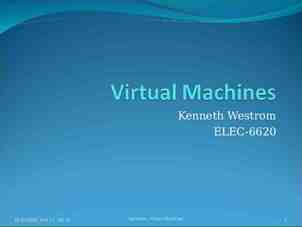studymafia Seminar On Performance Management Submitted To:
16 Slides292.24 KB
www.studymafia.org Seminar On Performance Management Submitted To: www.studymafia.org www.studymafia.org Submitted By:
Table of Content What is Performance Management? Performance Management Goals Performance Management Cycle Benefits of Performance Management Issues With Performance Management The New Performance Management Policy Key features of effective performance management software Conclusion
Introduction Performance Management is a key process in any organization and should assist the management and staff to focus on the key issues and business objectives to ensure sustainability. Traditionally, performance management has been a forward-looking solution based entirely on hindsight. But organizational culture is evolving to one of continuous feedback powered by technology, where managers can foresee problems based on current employee performance and initiate any form of course correction to bring the employee back on track.
What is Performance Management? Performance Management is an ongoing process where supervisors and employees work together to plan, monitor, and review an employee’s work objectives, goals, and professional development. comprised of frequent informal conversations including coaching, feedback and support to employees about their work, needs and accomplishments related to the duties and expectations of their positions.
Performance Management Process Cycle
The Performance Management Cycle 1. Planning This stage entails setting employees’ goals and communicating these goals with them. While these goals should be disclosed in the job description to attract quality candidates, they should be communicated once again when the candidate becomes a new hire. Depending on the performance management process in your organization, you may want to assign a percentage to each of these goals to be able to evaluate their achievement.
The Performance Management Cycle 2. Monitoring In this phase, managers are required to monitor the employees performance on the goal. This is where continuous performance management comes into the picture. With the right performance management software, you can track your teams performance in real-time and modify and correct course whenever required.
The Performance Management Cycle 3. Developing This phase includes using the data obtained during the monitoring phase to improve the performance of employees. It may require suggesting refresher courses, providing an assignment that helps them improve their knowledge and performance on the job, or altering the course of employee development to enhance performance or sustain excellence.
The Performance Management Cycle 4. Rating Each employees performance must be rated periodically and then at the time of the performance appraisal. Ratings are essential to identify the state of employee performance and implement changes accordingly. Both peers and managers can provide these ratings for 360-degree feedback. 5. Rewarding Recognizing and rewarding good performance is essential to the performance management process, as well as an important part of employee engagement. You can do this with a simple thank you, social recognition, or a full-scale employee rewards program that regularly recognizes and rewards excellent performance in the organization.
Benefits of Performance Management Integration Open Communication Improved Performance Training and Development Clarity of Standards/Requirements Placement of Individuals Increased Objectivity Equitable Remuneration Objective Promotability Structured Career Planning
Issues With Performance Management Legal issues. Untrained raters. Rater errors. Rater distortion. No grievance procedure. 11
The Performance Management Policy Supervisors must conduct at least four Expectations performance management activities with and goalInformal employees: Mid-point Summary setting conversation s conversation s conversation evaluation The goal setting, mid-point, and summary evaluation conversations must be documented.
Key features of effective performance management software Customization: It should be customizable to suit your organizations industry and performance management strategy. Transparency: It should be able to eliminate the confusion that both managers and their teams experience in the process of performance management. Objectivity: It should be able to offer objective metrics on which managers can base their performance evaluation. Frequency: It should allow for real-time, instant feedback and periodic employee ratings.
Conclusion Effective management of individual and team performance is a crucial and central requirement to ensure stakeholder requirements, organizational strategy and business goals are attained. This requires accurate data regarding performance levels of business units, teams and individuals, and therefore the need for a standardized and formal performance management system.
References www.google.com www.wikipedia.com www.studymafia.org www.pptplanet.com
Thanks





















